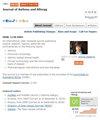Healthcare Resource Utilisation of Severe Uncontrolled T2low and Non-T2low Asthma in Finland During 2018-2021
IF 3.7
3区 医学
Q2 ALLERGY
引用次数: 0
Abstract
Purpose: Patients with asthma and low levels of type 2 inflammatory biomarkers (T2 low) have limited effective treatment options. Such biomarkers include eg blood eosinophils (b-eos) and fractional exhaled nitric oxide (FeNO). The healthcare resource utilisation (HCRU) of severe uncontrolled T2 low asthma remains unexplored. Thus, this study aimed to estimate the HCRU of T2 low and non-T2 low severe uncontrolled asthma patients using real-world data in Finland.Patients and Methods: Adult patients with an asthma diagnosis during baseline (2012– 2017) at the pulmonary department of Turku University Hospital were included and followed during 2018– 2021, or until death. Total HCRU costs and respiratory-related HCRU costs were evaluated. The main drivers for the HCRU and costs were assessed with gamma and negative binomial regression models.
Results: Of the severe uncontrolled asthma patients with T2 status available, 40% (N=66) were identified with T2 low and 60% (N=103) with non-T2 low asthma. The average cumulative cost per patient was similar in patients with T2 low compared with non-T2 low, with all-cause costs cumulating in four years of follow-up to 37,524€ (95% CI: 27,160, 47,888) in T2 low compared to 34,712€ (25,484, 43,940) in non-T2 low. The corresponding average cumulative respiratory-related costs were 5178€ (3150, 7205) in T2 low compared to 5209€ (4104, 6313) in non-T2 low. Regression modelling identified no differences between the T2-status groups when assessing all-cause healthcare costs per patient-year (PPY). On the other hand, the regression modelling predicted more inpatient days PPY for severe uncontrolled patients with T2 low status compared to the patients with non-T2 low status.
Conclusion: Patients with uncontrolled severe T2 low asthma use equal healthcare resources as corresponding non-T2 low patients. This study brought new insights into the HCRU of severe uncontrolled asthma patients per T2 status, which has not previously been investigated.
Keywords: severe uncontrolled asthma, phenotypes, healthcare resource utilisation, economic burden, real-world evidence
2018-2021年芬兰严重不受控制的T2low和非T2low哮喘的医疗资源利用情况
目的:哮喘患者的 2 型炎症生物标志物(T2 低)水平较低,有效的治疗方案有限。此类生物标志物包括血液嗜酸性粒细胞(b-eos)和呼出一氧化氮分数(FeNO)。对于严重失控的 T2 低哮喘患者,其医疗资源利用率(HCRU)仍有待探索。因此,本研究旨在利用芬兰的真实数据估算T2低度和非T2低度严重失控哮喘患者的医疗资源利用率:研究纳入了图尔库大学医院肺科在基线(2012-2017 年)期间确诊为哮喘的成年患者,并在 2018-2021 年期间进行了随访,直至患者死亡。评估了HCRU总成本和与呼吸相关的HCRU成本。采用伽马回归模型和负二项回归模型评估了HCRU和费用的主要驱动因素:在有 T2 状态的严重失控哮喘患者中,40%(66 人)被确定为 T2 低,60%(103 人)被确定为非 T2 低。与非T2低哮喘患者相比,T2低哮喘患者每名患者的平均累计费用相似,在四年的随访中,T2低哮喘患者的全因费用累计为37,524欧元(95% CI:27,160, 47,888),而非T2低哮喘患者的全因费用累计为34,712欧元(25,484, 43,940)。相应的与呼吸相关的平均累计费用为:T2 低度患者 5178 欧元(3150, 7205),非 T2 低度患者 5209 欧元(4104, 6313)。回归模型显示,在评估每位患者每年的全因医疗费用时,T2 状态组之间没有差异。另一方面,与非 T2 低状态患者相比,回归模型预测 T2 低状态严重失控患者的年住院天数更多:结论:未得到控制的严重 T2 低水平哮喘患者与相应的非 T2 低水平患者使用相同的医疗资源。这项研究为重度未控制哮喘患者每 T2 状态的 HCRU 带来了新的见解,而这在以前还没有过研究。 关键词:重度未控制哮喘、表型、医疗资源利用、经济负担、真实世界证据
本文章由计算机程序翻译,如有差异,请以英文原文为准。
求助全文
约1分钟内获得全文
求助全文
来源期刊

Journal of Asthma and Allergy
Medicine-Immunology and Allergy
CiteScore
5.30
自引率
6.20%
发文量
185
审稿时长
16 weeks
期刊介绍:
An international, peer-reviewed journal publishing original research, reports, editorials and commentaries on the following topics: Asthma; Pulmonary physiology; Asthma related clinical health; Clinical immunology and the immunological basis of disease; Pharmacological interventions and new therapies.
Although the main focus of the journal will be to publish research and clinical results in humans, preclinical, animal and in vitro studies will be published where they shed light on disease processes and potential new therapies.
 求助内容:
求助内容: 应助结果提醒方式:
应助结果提醒方式:


